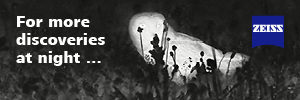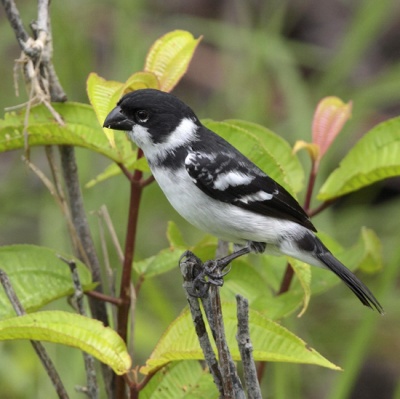- Sporophila americana
Identification
10-11 cm (4-4¼ in).
Adult male:
- Heavy black bill
- Black upperparts
- Greyish rump
- Two distinct white wing-bars
- White underparts
- Broad black pectoral collar
- Blackish mottling to the upper flanks
Female - brownish bill, dull buffy-olive upperparts and pale olive-ochre underparts
Juvenile: resemble adult females.
Distribution
South America: Tobago, North-eastern Venezuela, Guyana, Suriname, French Guiana, and Brazil.
On a local scale, Gray Seedeater and Wing-barred Seedeater seems to exclude each others presence.
Taxonomy
In the past, Variable Seedeater was included in this entity: the combined entity was known as Variable Seedeater but with scientific name Sporophila americana; much of the confusion arose as a result of misclassification of Caqueta Seedeater. Today, these three species and Gray Seedeater are seen as very closely related.
Subspecies
There are two subspecies[1]:
- S. a. americana:
- S. a. dispar;
- West Amazonian Brazil
Subspecies dispar is not recognized by all sources.
Habitat
Forest edges and second growth. Open or semi-open grassy areas and shrub in lowland along the coast or near the lower Amazon in Brazil.
Behaviour
The diet consists of seeds from grasses, sedges and weeds, flowers, buds and fruits.
Breeding
The nest is constructed from stems and tendrils lined with black fibres and is very similar to that of the Grey Seedeater.
References
- Clements, J. F., T. S. Schulenberg, M. J. Iliff, D. Roberson, T. A. Fredericks, B. L. Sullivan, and C. L. Wood. 2016. The eBird/Clements checklist of birds of the world: v2016, with updates to August 2016. Downloaded from http://www.birds.cornell.edu/clementschecklist/download/
- Handbook of the Birds of the World Alive (retrieved December 2016)
- SACC proposal to recognize Caqueta Seedeater
- Wikipedia
Recommended Citation
- BirdForum Opus contributors. (2024) Wing-barred Seedeater. In: BirdForum, the forum for wild birds and birding. Retrieved 1 May 2024 from https://www.birdforum.net/opus/Wing-barred_Seedeater





